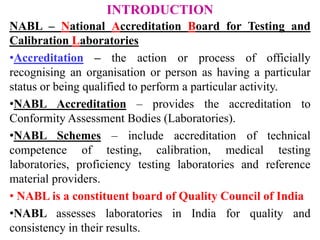NABL ACCREDITATION
- 1. NABLACCREDITATION UNIT I – CHAPT 6 Ms. TENY SARA THOMAS MOUNT ZION COLLEGE OF PHARMACEUTICAL SCIENCES AND RESEARCH, ADOOR, KERALA ASSISTANT PROFESSOR B.PHARM SIXTH SEMESTER PHARMACEUTICAL QUALITY ASSURANCE
- 2. CONTENTS Introduction Principles of NABLAccreditation Importance of Accreditation Benefits of Accreditation Accreditation Areas Approaches to obtain NABLAccreditation Accreditation procedure
- 3. INTRODUCTION NABL – National Accreditation Board for Testing and Calibration Laboratories •Accreditation – the action or process of officially recognising an organisation or person as having a particular status or being qualified to perform a particular activity. •NABL Accreditation – provides the accreditation to Conformity Assessment Bodies (Laboratories). •NABL Schemes – include accreditation of technical competence of testing, calibration, medical testing laboratories, proficiency testing laboratories and reference material providers. • NABL is a constituent board of Quality Council of India •NABL assesses laboratories in India for quality and consistency in their results.
- 4. IMPORTANCE OF NABLACCREDITATION •The concept of Laboratory Accreditation developed to provide a means of third – party certification of the competence of laboratories to perform specific types of testing and calibration. •Provides formal recognition of competent laboratories, thus providing a ready means for customers to find reliable testing and calibration services in order to meet their demands. •Enhances customer confidence in accepting testing calibration reports issued by accredited laboratories.
- 5. BENEFITS OF NABLACCREDITATION •Potential increase in business due to enhanced customer confidence and satisfaction •Savings in terms of time and money due to reduction or elimination of the need for re-testing •Better control of laboratory operations and feedback to laboratories as to whether they have sound quality assurance system and are technically competent. •Increase of confidence of testing/calibration data and personal performing work. •Customers can search and identify the laboratories accredited by NABL for the specific requirements from the directory of accredited laboratories. •Users of accredited laboratories will enjoy greater access for their products in both domestic and international markets.
- 6. NABLACCREDITATION AREAS TESTING LABORATORIES •Biological, chemical, electrical, testing, thermal, forensic CALIBRATION LABORATORIES •Electro-technical, mechanical, radiological, thermal, optical, fluid flow MEDICAL LABORATORIES •Clinical biochemistry, clinical pathology, genetics, cytopathology, serology area
- 7. APPROACHES TO OBTAIN ACCREDITATION 10 approaches for Accreditation 1. Awareness training should be given to the management and all the personnel involved. 2. Quality policy & Objectives should be established 3. Gap Analysis – analysis of all the departments in the company and the relationship between each departments 4. Documentation / process design 5. Documentation / process implementation 6. Internal audit by the company itself. 7. Management review meeting 8. Shadow audit – external audit 9. Corrective – preventive actions 10. Final certification audit
- 8. NABLACCREDITATION PROCESS 1. Application for accreditation 2. Acknowledgement & scrutiny of application by NABL secretariat 3. Adequacy of quality manual 4. Pre-assessment of laboratory by lead assessor 5. Final assessment of laboratory by assessment team 6. Scrutiny of assessment report by NABL secretariat 7. Recommendation for accreditation by accreditation committee 8. Approval for accreditation by chairman of NABL 9. Issue of NABL Certificate by NABL secretariat. During steps 2 - 6 feedback to laboratory is given and they are recommended to do the necessary corrective action.







